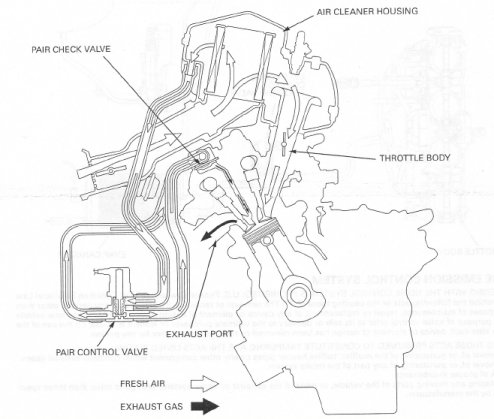
Honda CBR 1000RR PAIR System
May 2005
When doing research regarding the PAIR system I found there were quite a few questions other people had about the system, how it worked, and when, why, or if it should be disabled. I decided to do an article on it to try to answer these questions. The PAIR system is an emission control system. PAIR is an acronym for Pulse Secondary Air Injection. I'm not sure how Honda came up with PAIR from that, but none the less that's what the manual says it stands for. The PAIR system introduces filtered air into the exhaust ports to burn any unburned exhaust gases (read fuel vapor). Introducing air into a hot exhaust with fuel vapor will ignite this leftover fuel vapor turning it into CO2 and water vapor. According to Honda this greatly reduces the amount of environmentally harmful emissions coming from the 1000RR's exhaust. The PAIR system has ZERO affect on performance and weighs next to nothing. I can see no reason to remove the system as doing so only adds to air pollution. I'm no tree hugger by any means, but if the system doesn't hurt performance and only helps the environment I'm leaving it on the bike.

The issue is that the PAIR system will throw off the Air/Fuel readings on the dyno. You have air being injected into the exhaust that never passed through the combustion process. This will cause the dyno to read a leaner exhaust than is actually being produced by the motor. It will make the bike difficult to map properly using a PCIII. Therefore you should disable the system temporarily while on the dyno having a custom map created. I've heard a lot of people say they remove it to make the bike easier to work on. After going through all the trouble just to get to it, removing three hose clamps hardly seems like a chore if you're working on the bike. How much maintenance does a 1000RR require that would make this system a hindrance? There is no major maintenance required on the 1000RR for 16,000 miles and then we're just talking about 3 hose clamps to get the system out of the way. I can only see removing this system if your bike is purely for racing where you want to save every ounce possible in weight.
The PAIR system is located under the air box. To get to the system you'll need to remove the seat (2 x 5mm button head hex bolts), remove the tank side plates (2 x 5mm button head hex bolts), and remove the tank cover (4 x 5mm button head hex bolts). Disconnect the fuel tank drain tube and remove the 2 x 5mm tank bolts and lean the tank up and support it with a block of wood or other object. I recommend doing this while the bike has about half a tank of fuel as it will make the tank lighter. Remember to disconnect the fuel tank drain tube, it's easy to forget.
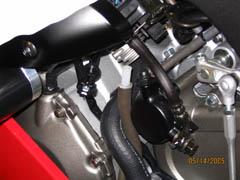 |
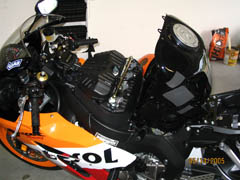 |
There is a rubber skirt around the air box. If you unhook a couple of the tabs on the right hand side you'll be able to see the PAIR tube that goes to the air box. For the purposes of dyno runs, you can pinch this hose off with a pair of locking vice grips and this will disable the system as no air can be pulled from the air box to be injected into the exhaust ports. Once the dyno runs are complete, simply unclamp the vice grips and button her up and you're done. It takes about 15 or 20 minutes to get to the hose if you take your time, and a little more than that to put things back together. When putting the tank cover back on the bike you may have a little difficulty with the rubber gasket that's around the fuel cap. It has a tendency to hang on the plastic tabs on the tank cover around the hole for the fuel cap. Applying some water to the rubber gasket will help the tank cover slide on easier.
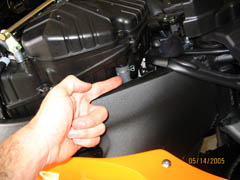 |
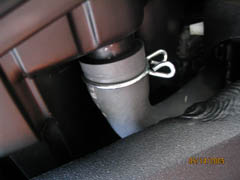 |
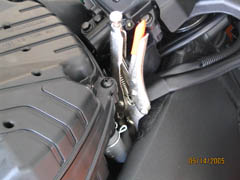 |
I will be doing baseline bone stock dyno runs tomorrow. Once I have the results I will post back the difference blocking the system made to the Air/Fuel ratio readings. For wide open throttle dyno runs disabling the system isn't necessary. I'm doing it more for testing to find out what difference it makes if any. For dyno tuning purposes and having a custom map created for your PCIII you'll definitely want to temporarily disable the system as those type of dyno runs are much more granular with longer periods at certain RPMs where the PAIR system will make a significant difference.
If you're racing and want to completely remove the system for the 8 ounces in weight it may save you, you'll have to do a little more work. Open the air box by removing the 6 phillips head screws and unplug the IAT sensor. Remove the air filters. BE CAREFUL that no debris falls out of the air filters and into the intake ports. I'd recommend laying a lint free towel over the intake ports just to be sure nothing gets in there. The air filters filter air from the inside out and mine were full of bugs and other debris. Loosen the upper fuel injector harness mounting tab to give some slack. Remove the upper air box housing by removing the 8 phillips head screws around its perimeter.
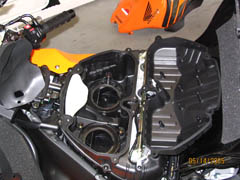 |
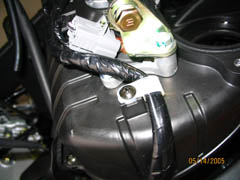 |
Next, loosen the 6 phillips screws in the bottom of the air box under where the air filters sit. Remove the 6 phillips screws and the air funnels that sit over the intake ports. Disconnect the crank case vent tube (the one with the white oil separator), and disconnect the PAIR hose from the air box. The lower air box should now come off of the bike.
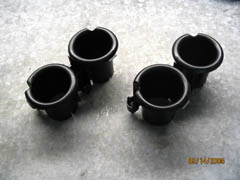 |
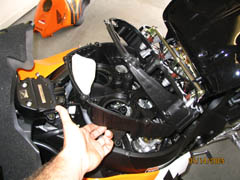 |
Now remove the PAIR system by removing the remaining two hose clamps holding the system to the valve covers. You'll need to go to Napa or CarQuest and buy three vacuum line caps in 5/8" size to cap off the air box and valve cover holes left after you remove the PAIR system. Use hose clamps or zip ties to hold the caps in place.
This page is part of a frame set. If you reached this page via a search engine please click here to go to the main page.